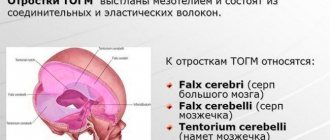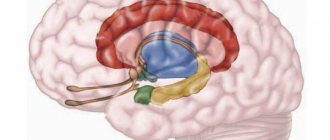The human brain is a unique, complex system. Due to it, the body can not only coordinate the work of all organs and force them to work as a single whole. The activity of highly organized cerebral structures allows a person to be a social being, capable of learning and cognition, to show multi-level emotions, and to have his own judgment about what is happening around him. To a greater extent, this is determined by the significant development of the cerebral cortex and a number of subcortical formations that make up the concept of the forebrain (or prosencephalon).
The forebrain is the most rostral cerebral section and includes in its structure two hemispheres with the gray matter of the cortex, subcortical structures and nerve fibers-conductors.
The functions of the forebrain include higher mental activity, complex reflex acts, the ability to cognition, features of a person’s emotional reactions and his socialization. Moreover, the cerebral structures of the anterior regions can determine what characteristics of character and temperament will be inherent in an individual.
During the process of ontogenesis, the forebrain is formed at the stage of three brain vesicles already at 3-4 weeks of embryonic development . This occurs by separating it from the midbrain (mesencephalon).
Closest to the spinal cord is the brain vesicle, which gives rise to the hindbrain (rhombencephalon). The latter, in turn, differentiates into two sections - metencephalon (from which the pons and cerebellum are formed) and myeltncephalon (forming the medulla oblongata). In some sources, the metencephalon is mistakenly called the forebrain, given that the anatomy of this formation determines its location anterior to the medulla oblongata. It would be more accurate to consider the metencephalon as the anterior part of the hindbrain.
By the end of the 4th week of gestation, the intermediate brain (diencephalon) and telencephalon (telencephalon), as well as the cavity of the third ventricle, are formed from the anterior medullary bladder prosencephalon.
General information
Formed from the anterior end of the primary neural tube.
In embryogenesis, it is divided into 2 parts, one of which gives rise to the telencephalon, the second - the intermediate brain. According to Alexander Luria’s model, it consists of 3 blocks:
- Block regulating brain activity levels. Ensures the implementation of certain types of activities. Responsible for emotional reinforcement of activity based on predicting its results (success - failure).
- Block for receiving, processing and storing incoming information. Participates in the formation of ideas about ways to implement activities.
- Block of programming, regulation and control over the organization of mental activity. Compares the resulting result with the original intent.
The forebrain takes part in the work of all blocks. Based on information processing, it controls behavior. Administrator of higher psychological functions: perception, memory, imagination, thinking, speech.
Forebrain
If you ask someone to draw the contents of a human skull, they will most likely draw a diagram of the hemispheres. This is truly one of the most noticeable and largest parts. But the forebrain also contains the medulla oblongata. In general, their structure is quite complex. And if we take into account a more detailed division, then we can even name all the parts of the forebrain:
Of course, there is an even more detailed division, but, as a rule, it is of interest only to specialists. Well, for those who are simply expanding their horizons, it will be much more interesting to find out what all these departments are doing. So what are the functions of the forebrain? And why are there differences between the thinking of right-handers and left-handers?
Anatomy
The structure of a living individual is not easy to describe. Especially such a component as the brain. This universe that exists in everyone continues to hide its secrets. But this does not mean that they are not worth understanding.
Development
The forebrain is formed at 3-4 weeks of prenatal development. By the end of the 4th week of embryogenesis, the telencephalon, diencephalon, and the cavity of the third ventricle are formed from the forebrain.
Diencephalon
It consists of the thalamic and hypothalamic regions, which are located on the sides of the third ventricle between the hemispheres and the midbrain.
The thalamic region unites:
- The thalamus is an ovoid formation located deep under the cerebral cortex. The oldest, largest (3-4 cm) formation of the diencephalon;
- The epithalamus is located above the thalamus. It is famous for the fact that it contains the pineal gland. Previously, it was believed that the soul lived here. Yogis associate the pineal gland with the seventh chakra. By awakening the organ, you can open the “third eye”, becoming clairvoyant. The gland is tiny, only 0.2 g. But the benefits for the body are enormous, although previously it was considered a rudiment;
- subthalamus - a formation located below the thalamus;
- metathalamus - bodies located in the posterior part of the thalamus (previously considered a separate structure). Together with the midbrain, they determine the work of the visual and auditory analyzers;
The hypothalamic region includes:
- hypothalamus. Located under the thalamus. Weighs 3-5 g. Consists of specialized groups of neurons. Connected with all departments. Controls the pituitary gland;
- the posterior lobe of the pituitary gland is the central organ of the endocrine system, weighing 0.5 g. Located at the base of the skull. The posterior lobe, together with the hypothalamus, forms the hypothalamic-pituitary complex, which controls the activity of the endocrine glands.
Finite brain
Unites:
- cortical hemispheres. The bark appeared late in the development of the animal world. Occupies half the volume of the hemispheres. Its surface can exceed 2000 cm2;
- corpus callosum - a nerve tract connecting the hemispheres;
- striped body. Located on the side of the thalamus. On a section it looks like repeating stripes of white and gray matter. Promotes regulation of movements, motivation of behavior;
- olfactory brain. Unites structures that differ in purpose and origin. Among them is the central section of the olfactory analyzer;
Evolutionary development
The modern school biology course covers topics from simple to complex. First we talk about cells, protozoa, bacteria, plants, fungi. Later there is a transition to animals and humans. To some extent, this reflects the hypothetical course of evolution. Looking at the structure of, for example, worms, it is easy to notice that it is much simpler than that of humans or higher animals. But these organisms have something important - a nerve ganglion that performs the functions of the brain.
The nervous system is generally extremely complex. It includes not only the brain and spinal cord, but also numerous processes consisting of special cells, as well as all the sensory organs. Thanks to this system, human life is possible in the form it exists. And, of course, the main organ in it is still the brain, which even in itself has a rather complex structure.
Anatomical features
Intermediate
The thalamus is egg-shaped and gray-brown in color. Structural unit - nuclei, which are classified according to functional and compositional characteristics.
The epithalamus consists of several units, the most famous of which is the grayish-reddish pineal gland.
The subthalamus is a small region of gray matter nuclei connected to white matter.
The hypothalamus consists of nuclei. There are about 30 of them. Most are paired. Classified by location.
Posterior lobe of the pituitary gland. The pituitary gland is a round-shaped formation, the location is the pituitary fossa of the sella turcica.
Finite
Unites the hemispheres, corpus callosum and striatum. The largest department by volume.
The hemispheres are covered with gray matter 1-5 mm thick. The mass of the hemispheres is about 4/5 of the mass of the brain. Convolutions and grooves significantly increase the area of the cortex, containing billions of neurons and nerve fibers arranged in a certain order. Underneath the gray matter lies white matter—the processes of nerve cells. About 90% of the cortex has a typical six-layer structure, where neurons are connected through synapses with each other.
From the point of view of phylogenesis, the cerebral cortex is divided into 4 types: ancient, old, intermediate, new. The main part of the human cortex is the neocortex.
The corpus callosum is shaped like a wide strip. Consists of 200-250 million nerve fibers. The largest structure connecting the hemispheres.
Structure and composition
Traditionally, there are five large parts of the brain: the pons, the cerebellum, the medulla oblongata, the midbrain and the cerebral hemispheres. But there is another method of separation. It includes the concepts of brainstem, hindbrain, midbrain and forebrain. The latter is precisely of the greatest interest, since it developed last - in lower vertebrates such division into hemispheres is not observed.
The composition of the brain is quite simple. More than half of its substance consists of water. The rest is lipids, minerals and proteins. It’s even strange what a trivial chemical composition such a complex organ as the brain has.
Functions
Mission – organization of mental activity.
Intermediate
Participates in coordinating the work of organs, regulating body movement, maintaining temperature, metabolism, and emotional background.
Thalamus . The main task is to sort information. It works like a relay - it processes and sends data coming from receptors and pathways to the brain. The thalamus affects the level of consciousness, attention, sleep, wakefulness. Supports speech functioning.
Epithalamus . Interaction with other structures occurs through melatonin, a hormone produced by the pineal gland in the dark (therefore, it is not recommended to sleep in the light). A derivative of serotonin - the “happiness hormone”. Melatonin is a participant in the regulation of circadian rhythms, being a natural sleep aid, it affects memory and cognitive processes. It affects the localization of skin pigments (not to be confused with melanin), puberty, and suppresses the growth of a number of cells, including cancer cells. Through connections with the basal ganglia, the epithalamus participates in the optimization of motor activity, and through connections with the limbic system, in the regulation of emotions.
Subthalamus . Controls the body's muscle responses.
Hypothalamus . Forms a functional complex with the pituitary gland and directs its work. The complex controls the endocrine system. The hormones it produces help cope with distress and maintain homeostasis.
Thirst and hunger centers are located in the hypothalamus. The department coordinates emotions, human behavior, sleep, wakefulness, and thermoregulation. Endorphins similar in action to opiates are found here, which help to endure pain.
Finite brain
Hemispheres
They act together with subcortical structures and the brain stem. Main destination:
- Organization of interaction of an organism with the environment through its behavior.
- Consolidation of the body.
Corpus callosum
The corpus callosum received attention after operations to dissect it in the treatment of epilepsy. The operations relieved seizures while changing a person’s personality. It was found that the hemispheres are adapted to work independently. However, to coordinate activities, information exchange between them is necessary. The corpus callosum is the main transmitter of information.
Striatum
- Reduces muscle tone.
- Contributes to the coordination of internal organ function and behavior.
- Participates in the formation of conditioned reflexes.
The olfactory brain contains centers that control the sense of smell.
Cerebral cortex
Head of mental processes. Controls sensory and motor functions. Consists of 4 layers.
The ancient layer is responsible for elementary responses (for example, aggression) characteristic of humans and animals.
The old layer is involved in the formation of attachment and laying the foundations of altruism. Thanks to the layer we are happy or angry.
The intermediate layer is a formation of a transitional type, since the modification of old formations into new ones is carried out gradually. Ensures the activity of the new and old cortex.
The neocortex concentrates information from subcortical structures and the brainstem. Thanks to it, living beings think, talk, remember, and create.
5 cerebral lobes
The occipital lobe is the central section of the visual analyzer. Provides visual pattern recognition.
Parietal lobe:
- controls movements;
- orients in time and space;
- provides perception of information from skin receptors.
Thanks to the temporal lobe, living things perceive a variety of sounds.
The frontal lobe regulates voluntary processes, movements, motor speech, abstract thinking, writing, self-criticism, and coordinates the work of other areas of the cortex.
The insula is responsible for the formation of consciousness, the formation of an emotional response and the maintenance of homeostasis.
Interaction with other structures
The brain matures unevenly during ontogenesis. At birth, unconditioned reflexes are formed. As the individual matures, conditioned reflexes develop.
The parts of the brain are anatomically and functionally interconnected. The trunk, together with the cortex, is involved in the preparation and implementation of various forms of behavior.
The interaction of the thalamus, limbic system, hippocampus helps to reproduce the image of events: sounds, smells, place, time, spatial location, emotional coloring. The connections of the thalamus with areas of the temporal lobe of the cortex contribute to the recognition of familiar places and objects.
The thalamus, hypothalamus, and cortex have mutual connections with the medulla oblongata. Thus, the medulla oblongata contributes to the assessment of receptor activity and the normalization of the activity of the musculoskeletal system.
Cooperation of the reticular formation of the trunk and cortex causes excitation or inhibition of the latter. The cooperation of the reticular formation of the medulla oblongata and the hypothalamus ensures the functioning of the vasomotor center.
Having examined the structure and purpose, we are one step closer to understanding a living entity.
The human brain is an extremely complex system. Thanks to this organ, people have reached the level of development that is observed now. What is he like?
Interesting Facts
- Thinking abilities do not depend on the mass of the brain, but correlate with such a value as the number of convolutions.
- The speed of signals between neurons reaches 288 kilometers per hour. As you get older, this figure decreases.
- The brain consumes the largest amount of energy among human organs - about 20%. This is a huge indicator, considering that its mass in relation to the body is only 2%. Also, for its normal operation, a sufficient amount of fluid in the body is necessary.
- The statement that the brain uses only 10% of its resources is a myth. Indeed, not many centers can work at the same time, but one way or another they are all involved.









